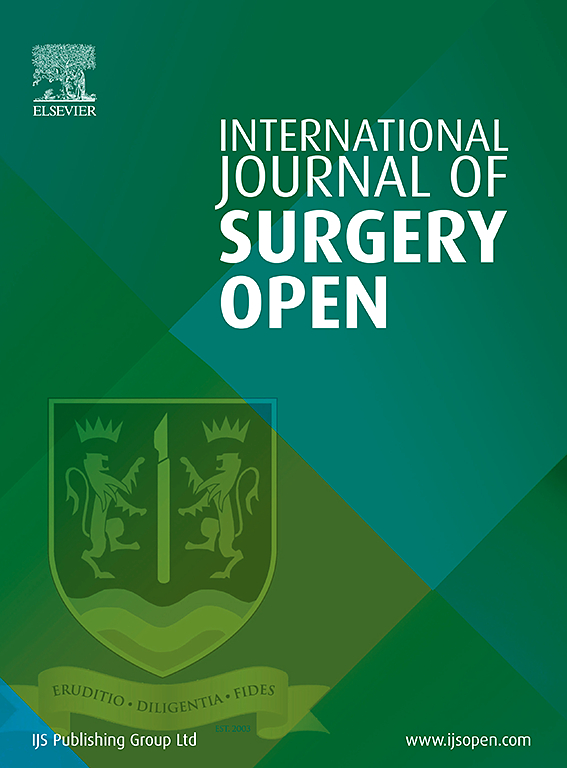摘要
背景:三维建模是外科领域的一项新兴技术,可应用于手术规划、外科教育和患者参与。新陈代谢手术是治疗肥胖症最有效的方法,它的日益普及带来了新的复杂的临床挑战。本系统性综述旨在了解三维建模在代谢手术中的应用及其对临床结果的影响:方法:按照注册协议(PROSPERO:XXX),使用 MEDLINE、Embase 和 CENTRAL Cochrane 图书馆进行了全面检索。对符合条件的论文进行了筛选和全文审阅。在对现有体积数据进行荟萃分析的同时,还进行了定性专题分析。结果按照 PRISMA 指南进行报告:结果:共纳入 29 项研究,其中大部分为二级证据(n = 19,66%)。研究侧重于手术计划和手术实践(90%,n = 26),并细分为术前计划(14%,n = 4)、术后诊断(31%,n = 9)以及术后评估和预测(45%,n = 13)。只有三篇论文涉及手术教育(10%)。用于患者教育的三维建模尚未被研究。为评估三维建模的跨研究一致性,对术前和术后三维胃容积测量和腹围进行了汇总荟萃分析。术前平均胃容量为 794.93 mL(95% 置信区间 [CI]:518.61-1071.26 mL)。术后 LSG 和 RYGB/OAGB 胃容量分别为 171.71 mL(95% 置信区间:113.37-288.58 mL)和 35.73 mL(95% 置信区间:29.32-42.14 mL)。平均腹围为 120.04 厘米(95% CI:100.72-139.35 厘米)。所有体积均与已发表的数据一致:本系统综述强调了三维建模在容积评估方面的准确性及其在手术规划和培训中的发展作用。然而,其在 AR 或 3DP 模型、患者教育或利用三维容积研究回答减肥手术辩论方面的潜在优势仍未得到充分利用。Background: Three-dimensional (3D) modeling is an emerging technology in surgery, with applications in operative planning, surgical education, and patient engagement. Metabolic surgery, the most effective treatment for obesity, is increasingly prevalent leading to new complex clinical challenges. This systematic review aims to understand the use of 3D modeling in metabolic surgery and its impact on clinical outcomes.
Methods: Following a registered protocol (PROSPERO: XXX), a comprehensive search using MEDLINE, Embase, and CENTRAL Cochrane Library was conducted. Eligible papers underwent screening and full-text review. A qualitative thematic analysis was performed alongside meta-analyses on available volumetric data. Results were reported as directed by the PRISMA guidelines.
Results: Twenty-nine studies were included, with most at Level II evidence (n = 19, 66%). Studies focused on operative planning and surgical practice (90%, n = 26) and were subdivided into preoperative planning (14%, n = 4), postoperative diagnosis (31%, n = 9), and postoperative assessment and prediction (45%, n = 13). Only three papers addressed surgical education (10%). 3D modeling for patient education was unexplored. To assess 3D modeling's cross-study consistency, pooled meta-analyses on preoperative and postoperative 3D gastric volumetry and abdominal circumference were performed. Average preoperative stomach volume was 794.93 mL (95% confidence interval [CI]: 518.61-1071.26 mL). Postoperative LSG and RYGB/OAGB gastric volumes were 171.71 mL (95% CI: 113.37-288.58 mL) and 35.73 mL (95% CI: 29.32-42.14 mL) respectively. Average abdominal circumference was 120.04 cm (95% CI: 100.72-139.35 cm). All volumes were consistent with published data.
Conclusions: This systematic review highlighted the accuracy of 3D modeling for volumetric assessments and its developing role in surgical planning and training. However, its potential benefits in AR or 3DP models, in patient education or for answering bariatric surgical debates using 3D volumetric studies remain underutilized.

 求助内容:
求助内容: 应助结果提醒方式:
应助结果提醒方式:


